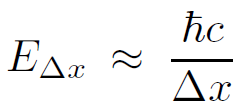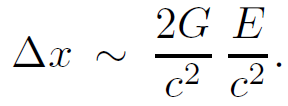


 الفيزياء الكلاسيكية
الفيزياء الكلاسيكية
 الكهربائية والمغناطيسية
الكهربائية والمغناطيسية
 علم البصريات
علم البصريات
 الفيزياء الحديثة
الفيزياء الحديثة
 النظرية النسبية
النظرية النسبية
 الفيزياء النووية
الفيزياء النووية
 فيزياء الحالة الصلبة
فيزياء الحالة الصلبة
 الليزر
الليزر
 علم الفلك
علم الفلك
 المجموعة الشمسية
المجموعة الشمسية
 الطاقة البديلة
الطاقة البديلة
 الفيزياء والعلوم الأخرى
الفيزياء والعلوم الأخرى
 مواضيع عامة في الفيزياء
مواضيع عامة في الفيزياء|
Read More
Date: 22-12-2015
Date: 12-2-2017
Date: 23-12-2015
|
Horizons and the UV/IR Connection
The overriding theme of 20th century physics was the inverse relation between size and momentum/energy. According to conventional relativistic quantum mechanics, a size Δx can be probed with a quantum of energy
 (1.1)
(1.1)
But we already know that this trend is destined to be reversed in the physics of the 21st century. This can be seen in many ways. Let's begin with a traditional attempt to study interactions at length scales smaller than the Planck scale. According to conventional thinking, what we need to do is to collide, head on, particles with center of mass energy EΔx. We expect to discover high energy collision products flying out at all angles. By analyzing the highest energy fragments, we hope to reconstruct very short distance events.
The problem with this thinking is that at energies far above the Planck mass, the collision will create a black hole of mass ∼ EΔx. The interesting short distance effects that we want to probe will be hidden behind a horizon of radius

and are inaccessible. To make matters worse, the products of collision will not be high energy particles, but rather low energy Hawking radiation. The typical Hawking particle has energy ∼ hc/RS which decreases with the incident energy. Thus we see that a giant “Super Plancketron” Collider (SPC) would fail to discover fundamental length scales smaller than the Planck scale ℓP , no matter how high the energy. In fact, as the energy increases we would be probing ever larger scales
 (1.2)
(1.2)
We might express this in another form as a kind of space-time uncertainty principle:
 (1.3)
(1.3)
This is the simplest example of the ultraviolet/infrared connection that will control the relation between frequency and spatial size. Very high frequency is related to large size scale.
The UV/IR connection is deeply connected to black hole complementarity. As we saw in the previous lecture, the enormous differences in the complementary descriptions of matter falling into a black hole are due to the very different time resolutions available to the complementary observers.
Let's consider further: what happens to a proton falling into the black hole? The proton carries some information with it; its charge, particle type, momentum, location on the horizon through which it falls, etc. From the viewpoint of the external observer, the proton is falling into an increasingly hot region. The proton is like a tiny piece of ice thrown into a tub of very hot water. The only reasonable expectation is that the constituents of the proton “melt” and diffuse throughout the horizon. In fact, we saw just such a phenomenon involving a charge falling onto the stretched horizon. More generally, all of the information stored in the incident proton should quickly be spread over the horizon. On the other hand, the observer who follows the proton does not see it spread at all as it falls.
The need to reconcile the complementary descriptions gives us an important clue to the behavior of matter at high frequencies. Following the proton as it falls, the amount of proper time that it has before crossing the horizon tends to zero as the Schwarzschild time tends to infinity. Call the proper time Δτ. Then Δτ varies with Schwarzschild time like
 (1.4)
(1.4)
Thus in order to observer the proton before it crosses the horizon, we have to do it in a time which is exponentially small as t → ∞. Thus, what we need in order to be consistent with the thermal spreading of information is now clear. As the proton is observed over shorter and shorter time intervals, the region over which it is localized must grow.
In fact, if we assume that it grows consistently with the uncertainty relation in equation 1.3 (substituting Δτ for Δt) we obtain

Thus, if the proton size depends on the time resolution according to equation 1.3, it will spread over the horizon exponentially fast.
The idea of information spreading as the resolving time goes to zero is very unfamiliar, but it is at the heart of complementarity. It is implicit in the modern idea of the UV/IR connection. Fortunately it is also built into the mathematical framework of string theory.



|
|
|
|
التوتر والسرطان.. علماء يحذرون من "صلة خطيرة"
|
|
|
|
|
|
|
مرآة السيارة: مدى دقة عكسها للصورة الصحيحة
|
|
|
|
|
|
|
نحو شراكة وطنية متكاملة.. الأمين العام للعتبة الحسينية يبحث مع وكيل وزارة الخارجية آفاق التعاون المؤسسي
|
|
|